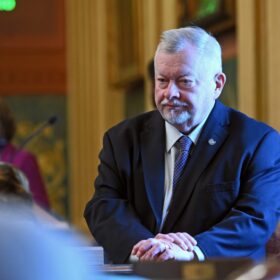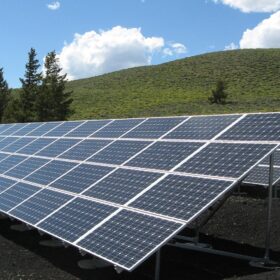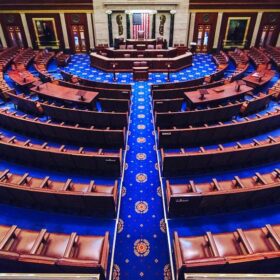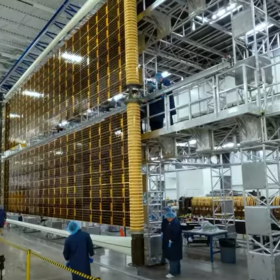Top News
In case you missed it: Six big solar stories in the news this week

The ‘MAGA Solar Act’: Michigan Republicans’ solar playbook

Five reasons solar and wind are core to U.S. energy
Out now - pv magazine Global June edition
MediaKit 2025

House passage of One Big Beautiful Bill sends solar industry reeling

Redwire deploys 60 kW roll-out solar array for the first lunar orbit space station
Older Americans encouraged to go solar through Third Act and EnergySage partnership
How energy storage could solve the growing power crisis in the U.S.
Canada’s path to 2030: Tripling renewables and land conservation are both possible
Press Releases
Enertis Applus+ Delivers Independent Engineering Expertise to Texas BESS Projects Totaling 550 MW for Excelsior Energy Capital
Fronius Launches Remote Configuration and Configuration Report Features to Simplify U.S. DER Interconnection Process with Utilities
Deal Orchards’ Solar Installation Generates 75% of Its Energy Needs, Expanding Efforts to Reduce Its Environmental Impact While Saving Money
Survey: Extreme Natural Disasters, Soaring Energy Bills and a Failing Power Grid Spark Demand for Better Household Solar and Backup Battery Solutions
Installations
Featured
Utility-scale solar developer Arevon secures $600 million portfolio funding
Largest solar project in Wisconsin history gets the wildlife greenlight
The Wisconsin Wildlife Federation and Vista Sands Solar project reached an agreement to allow the 1.3 GW project to maintain its size while also protecting the greater prairie-chickens.
Redwood, Crusoe deploy second-life batteries at AI data center for 63 MWh storage
The second-life project represents the second largest deployment in North America, and the largest battery-powered microgrid.
Solar installers learn to be nimble in selling batteries
pv magazine USA spoke to solar installers who learned first-hand that interest in batteries can vary from customer to customer, as it can often depend on geography and state policy, among other factors.
Tackling affordable housing, climate action together under (or on) one roof
A 333 kW rooftop solar project was installed atop a modular home factory in Boulder, Colorado.
Largest solar project in Southwest Public Power Agency territory is activated
The 300 MW Box Canyon solar project was developed by BrightNight and Cordelio Power.
Manufacturing
Featured
Solar manufacturer closes 45X tax credit transfer
Trinasolar targeting ‘high-value’ markets
Yang Bao, Trinasolar’s president of global sales and marketing, recently spoke with pv magazine about the company’s strategy for the solar and energy storage business.
U.S. solar manufacturers seek to match rhetoric with reality
An extension of 48E tax credit with the domestic content bonus levels the playing field, say Qcells’, Talon PV and SEMA execs, so U.S. manufacturers can pay off the factories that they invested in in good faith against these credits.
Policy uncertainty leads to $1.4 billion cancelled U.S. manufacturing investments in May
Republican districts are hit the hardest, with more than $9 billion in investments cancelled, delayed or closed so far in 2025, as businesses react to House and Senate bills that propose an early end or elimination of tax credits, according to E2.
Texas solar module manufacturer sells $50 million in tax credits
SEG Solar closed a sale of 45X manufacturing tax credits. The company reports it has invested more than $60 million in its Houston facility, which has achieved an annual production capacity of 2 GW through two fully automated production lines.
Focus on domestic content boosts solar executive’s confidence
OMCO Solar’s Eric Goodwin shared insight with pv magazine USA on a solar industry that eagerly awaits further federal recognition of the value of domestically manufactured solar mounting systems.
Markets & Policy
GameChange Solar introduces terrain-following tracker designed to reduce land grading
State lawmakers convene to tackle grid strain, data center energy demands
The Pew Charitable Trust held a two-day meeting in San Antonio where state lawmakers met to learn about distributed energy resources and discuss policies can help meet rising energy demands.
What is solar net metering?
In many states, rooftop solar is supported by a billing structure called net metering, under which utility bills are credited for exporting electricity to the grid.
How ERCOT’s upcoming RTC+B program could unlock new value streams for storage
ERCOT’s long-anticipated real-time co-optimization initiative marks a fundamental shift in how batteries are treated, dispatched and monetized across the Texas grid.
People on the move: GridBeyond, Haven Energy, Weideman Group and more
Job moves in solar, storage, cleantech, utilities and energy transition finance. And the job of the week.
Oregon expands microgrids to beyond utility ownership
The legislation strives to build resiliency at the community level by allowing private developers to build, own and operate microgrids.
Technology
Featured
Speeding interconnection through automation is a proven technology, says software executive
U.S. startup offers tin oxide, nickel oxide materials for flexible perovskite solar cells, modules
Sofab Inks, a spinoff of University of Louisville, said its transport layer materials enable perovskite solar cells with greater stability, efficiency, and scalability compared to incumbent materials.
Google aims to boost transmission capacity with advanced conductor upgrades
Google aims to help deliver more power to areas where it has data centers, by funding projects that increase the capacity of existing transmission lines using advanced conductors made by CTC Global. Large solar projects near reconductored lines could benefit.
Yes in my backyard: research rejects ‘NIMBY’ hypothesis for solar opposition
Most people who live near large-scale solar projects have positive or neutral feelings about the solar project and only 18% would be opposed to additional solar projects, found a national survey published in Frontiers in Sustainable Energy Policy.
Batteries are stabilizing the Texas power grid
A study by North American Electric Reliability Corporation found that ultra-fast response times of batteries help to stabilize the grid better than slower thermal sources.
Abandoned coal mines can host over 10% of global solar capacity
A survey of mines closed since 2020 and those planned to close by 2030 present an opportunity for installing nearly 300 GW solar on already-developed lands, finds a report from Global Energy Monitor.


